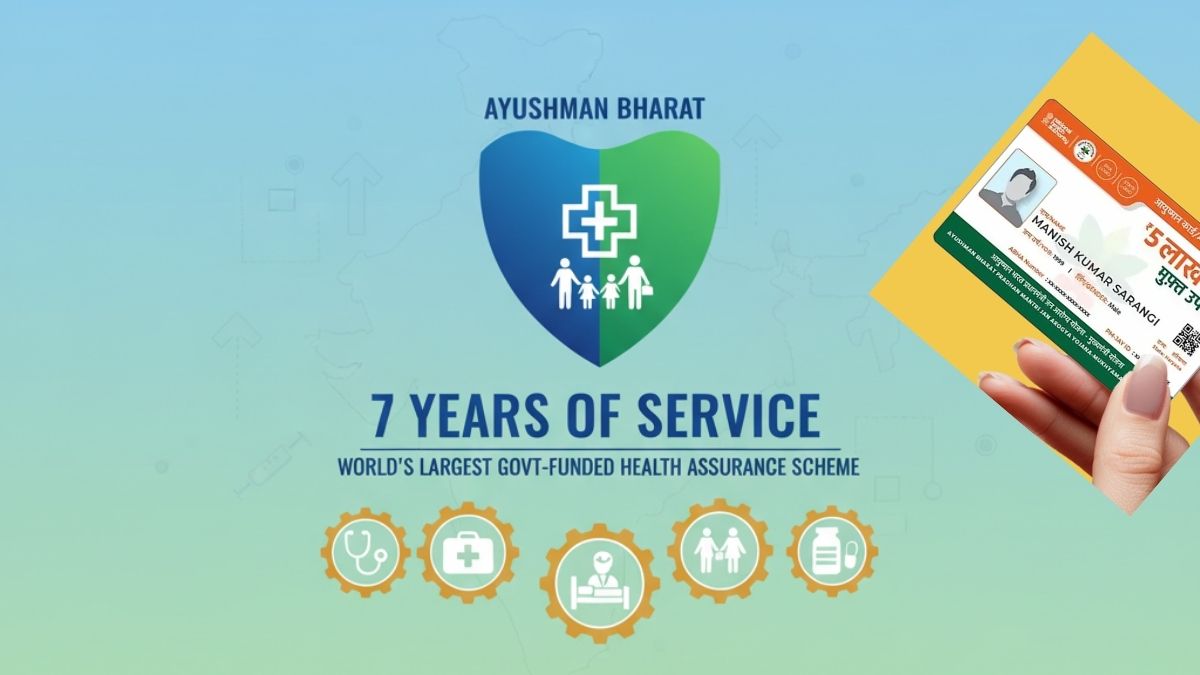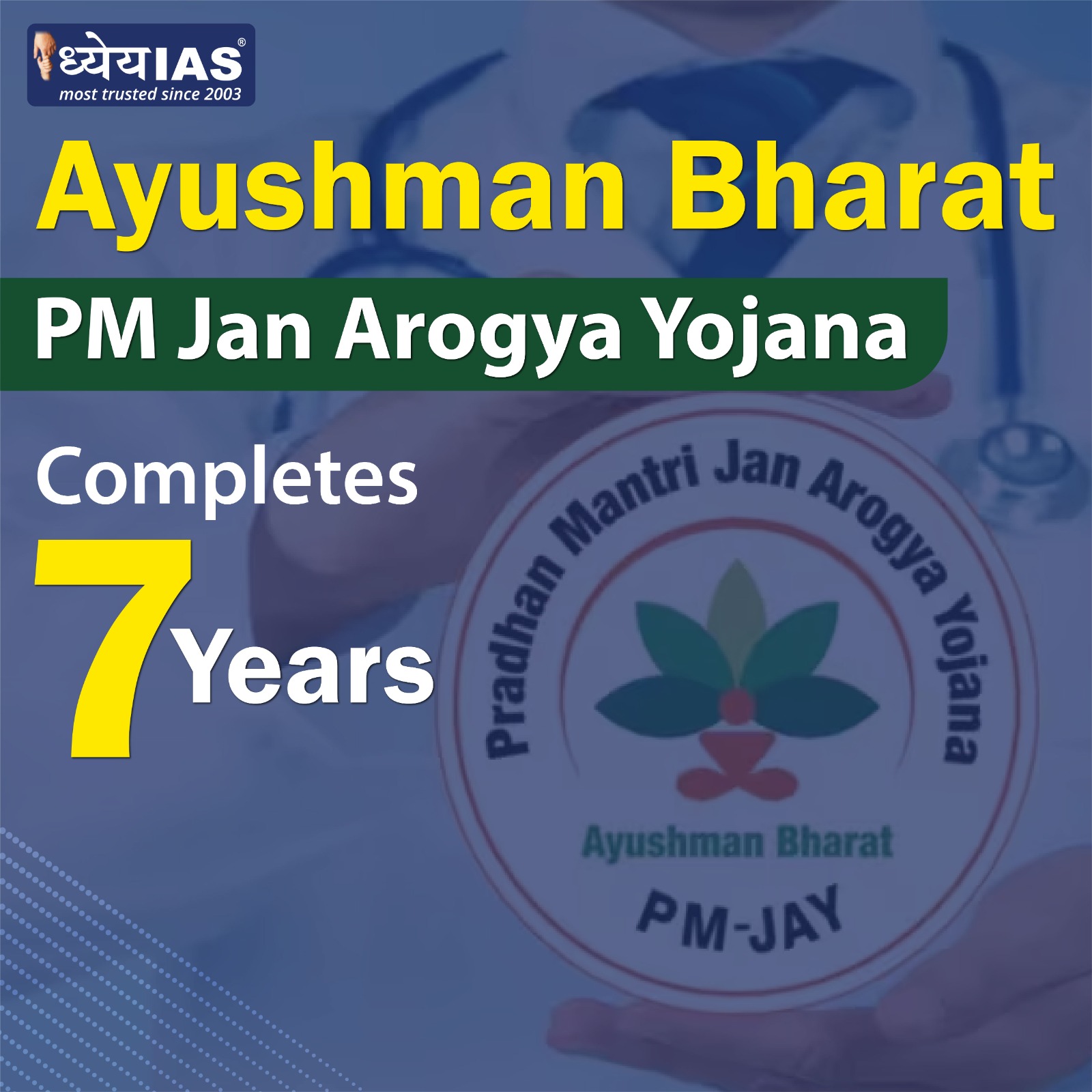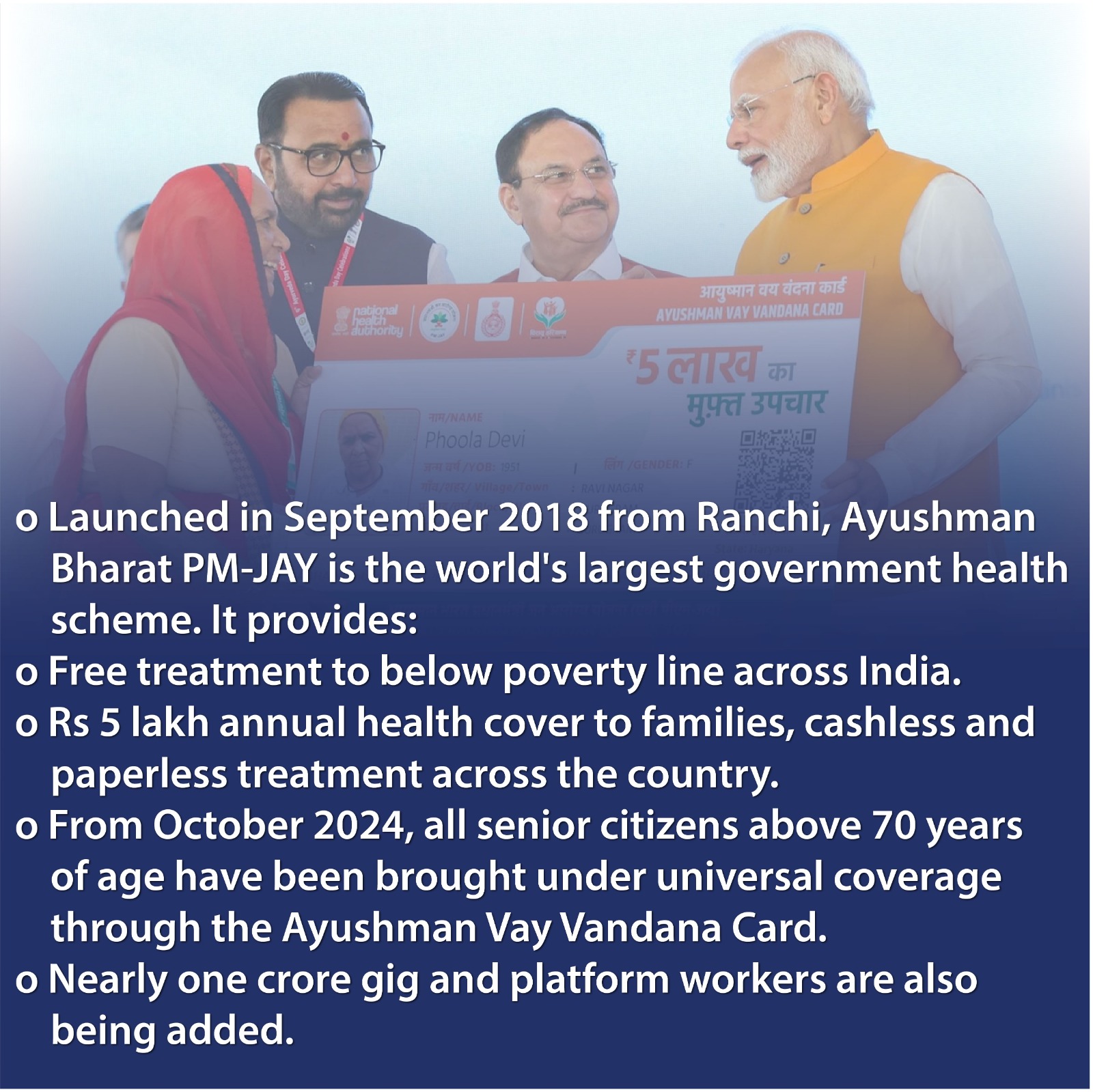Context:
India’s healthcare system has long been characterised by limited access to quality treatment and high dependence on personal savings. Every year, nearly 6 crore Indians are pushed into poverty due to medical expenses. For decades, health insurance remained beyond the reach of the poor, forcing families to borrow or sell assets during medical emergencies.
-
-
- Against this backdrop, the launch of Ayushman Bharat Pradhan Mantri Jan Arogya Yojana (AB PM-JAY) in 2018 was a turning point. By offering ₹5 lakh cashless cover per family annually, the scheme aimed to provide financial protection and dignity to the most vulnerable. As it completes seven years in 2025, the numbers are striking: over 6.5 crore surgeries and treatments, nearly ₹82,000 crore spent by the government, and more than 32,000 hospitals empaneled. These figures reflect how PM-JAY has redefined public health delivery in India.
- Against this backdrop, the launch of Ayushman Bharat Pradhan Mantri Jan Arogya Yojana (AB PM-JAY) in 2018 was a turning point. By offering ₹5 lakh cashless cover per family annually, the scheme aimed to provide financial protection and dignity to the most vulnerable. As it completes seven years in 2025, the numbers are striking: over 6.5 crore surgeries and treatments, nearly ₹82,000 crore spent by the government, and more than 32,000 hospitals empaneled. These figures reflect how PM-JAY has redefined public health delivery in India.
-
|
About the Scheme:
The scheme is a step towards Universal Health Coverage (UHC), aligning with India’s commitment under SDG 3 (Good Health and Well-Being). |
Twin Pillars of Ayushman Bharat
1. Ayushman Arogya Mandirs (AAMs)
o Over 1.5 lakh centres across the country.
o Provide comprehensive primary healthcare free of cost, including maternal and child health, non-communicable diseases, mental health, oral and eye care, and palliative support.
o By shifting focus from curative to preventive and promotive care, these centres aim to reduce the long-term disease burden.
2. PM-JAY
o Provides cashless and paperless coverage up to ₹5 lakh per family per year.
o Includes 3 days pre-hospitalisation and 15 days post-hospitalisation expenses, a rare feature in government schemes.
o Covers all pre-existing conditions from day one, which is crucial since chronic diseases are common among low-income families.
o Offers nationwide portability, allowing beneficiaries to seek treatment anywhere in India — critical for migrant workers and interstate laborers.
Progress in Seven Years:
Scale of Reach
-
-
-
- 55 crore Ayushman cards issued, covering nearly 40% of India’s population.
- 7.79 crore hospital admissions supported since launch.
- Government has spent almost ₹82,000 crore on claim settlements.
- Over 32,000 empaneled hospitals, creating one of the largest hospital networks under a single scheme globally.
- 55 crore Ayushman cards issued, covering nearly 40% of India’s population.
-
-
Regional Distribution
-
-
-
- Tamil Nadu tops with 90 lakh admissions, showing high levels of institutional participation.
- Karnataka: around 66 lakh admissions.
- Rajasthan: 57 lakh.
- Kerala: nearly 55 lakh.
- West Bengal is the only state that has chosen not to implement the scheme.
- Tamil Nadu tops with 90 lakh admissions, showing high levels of institutional participation.
-
-
Beneficiaries by Age
-
-
-
- 45–59 years: 1.15 crore admissions, reflecting the heavy burden of lifestyle diseases in the middle-aged population.
- Above 60 years: over 1 crore hospitalisations.
- In 2024, the scheme was extended to all citizens above 70 years, irrespective of income, providing significant relief to senior citizens who often face chronic and costly ailments.
- 45–59 years: 1.15 crore admissions, reflecting the heavy burden of lifestyle diseases in the middle-aged population.
-
-
Treatments and Specialities
-
-
-
- Hemodialysis: Over 64 lakh admissions, costing the government ₹2,521 crore. The high number highlights the rising prevalence of kidney disorders, often linked to diabetes and hypertension.
- Other major treatments: cardiac surgeries, stenting, caesarean deliveries, orthopedic procedures like hip and knee replacements, and treatment for anemia and acute febrile illnesses.
- By Specialty:
- Cardiology – ₹4,222 crore in claims.
- General medicine – ₹4,102 crore.
- Cancer care (medical + radiation oncology) – ₹4,800 crore.
- Cardiology – ₹4,222 crore in claims.
- Hemodialysis: Over 64 lakh admissions, costing the government ₹2,521 crore. The high number highlights the rising prevalence of kidney disorders, often linked to diabetes and hypertension.
-
-
Significance of PM-JAY:
1. Reducing Financial Hardship
o Before PM-JAY, households often sold land or borrowed at high interest to afford hospitalisation. With ₹5 lakh cover, the scheme protects families from such catastrophic spending.
2. Equity in Access
o By focusing on the poorest 40%, the scheme ensures that those most likely to skip treatment due to cost now have access.
3. Strengthening Primary and Preventive Care
o Ayushman Arogya Mandirs emphasise wellness and disease prevention, addressing risk factors before they escalate into hospitalisation.
4. Nationwide Portability
o Important for migrant workers, truck drivers, and labourers who often travel across states. The portability feature ensures they are not tied to their home district.
5. Women-Centric Coverage
o Nearly half the Ayushman cards are held by women, helping correct gender gaps in healthcare access, especially in rural areas where women’s health needs are often neglected.
6. Boost to the Healthcare Economy
o By creating demand for hospital services, PM-JAY has spurred investment in healthcare infrastructure and employment in the medical sector.
Key Challenges:
1. Exclusion of Outpatient Care
o Outpatient consultations, diagnostic tests, and medicines are not covered, even though these account for nearly 70% of health expenses for households.
2. Hospital Participation Issues
o Many private hospitals remain hesitant due to low reimbursement rates and delayed claim settlements. Public hospitals therefore bear disproportionate load.
3. Fraud and Misuse
o Reports of fake beneficiaries, inflated bills, and unnecessary surgeries raise questions about monitoring mechanisms.
4. Awareness Gaps
o Millions of eligible households still do not know they are entitled to benefits. Rural and remote regions are particularly affected.
5. Financial Sustainability
o Rising claims put pressure on government budgets. States with weaker finances struggle to meet their share of costs.
6. Uneven Quality of Care
o While some hospitals provide high-quality treatment, others lack specialists or infrastructure, leading to inconsistent outcomes.
Wider Implications:
-
-
- Health Security as Social Security: PM-JAY marks a shift in thinking — treating healthcare not as a privilege but as a basic guarantee.
- Federal Collaboration: With most states adopting it, the scheme reflects cooperative federalism in action.
- Global Leadership: PM-JAY is among the largest public health assurance schemes worldwide, comparable in scale to insurance systems in advanced economies.
- Pathway to UHC: By covering hospitalisation while expanding primary healthcare, India is moving closer to Universal Health Coverage.
- Catalyst for Private Sector Participation: The scheme has nudged private hospitals to serve low-income groups, though challenges remain.
- Health Security as Social Security: PM-JAY marks a shift in thinking — treating healthcare not as a privilege but as a basic guarantee.
-
Conclusion:
The journey of Ayushman Bharat PM-JAY over seven years underscores how a well-designed public policy can transform lives at scale. By offering protection against catastrophic health expenditure, it has brought dignity and confidence to millions of poor households. It has also expanded access to life-saving treatments for chronic conditions like kidney disease, heart ailments, and cancer.
| UPSC/PSC main question: “Universal Health Coverage (UHC) is not merely about financial protection, but also about equitable and quality access.” In this context, evaluate the contribution of Ayushman Bharat in bridging India’s healthcare inequities. |









